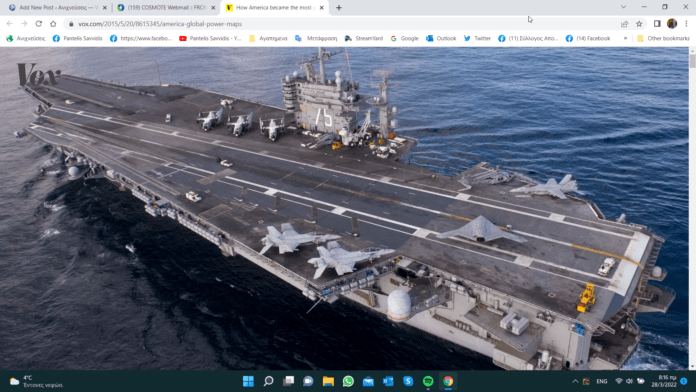How America became the most powerful country on Earth, in 11 maps
We take it for granted that the United States is the most powerful country on Earth today, and perhaps in human history. The story of how that came to be is long, fascinating, complex — and often misunderstood. Here, excerpted in part from “70 maps that explain America,” are maps that help show some of the key moments and forces that contributed to the US’s rise as sole global superpower.
Because of a war that left North America vulnerable to British conquest — and thus ready for the US’s expansion
:no_upscale()/cdn.vox-cdn.com/uploads/chorus_asset/file/3702196/map-7yr-war.0.0.jpg)
So much of America’s power comes from its size: it is one the largest countries on Earth by population and area, and is rich in natural resources and human capital. It is also in many ways an island nation; because it faces no major threats on its borders, it is freer to project power globally.
There was no reason that North America’s borders had to become what they are. A key moment in how that happened came with the French and Indian War, at the time just a sideshow in the larger Seven Years’ War in Europe. The war ended with France giving up its vast territory on the continent to Britain and Spain. Napoleon would seize back Louisiana and sell it to the US in 1803, but New France was lost forever. With the Spanish Empire already declining, the continent was left open to conquest from the British Empire and its successor, the United States.
Image credit: University of Maine
By stealing Native Americans’ land for an entire century
/cdn.vox-cdn.com/uploads/chorus_asset/file/3702204/native-american-land__.0.0.gif)
Of course, North America was not empty when European explorers and settlers arrived — it was filled with diverse, long-established societies. They may well have become sovereign nation-states had the US not sought to purge them from their lands, deny them self-rule, and, once they had been reduced to a tiny minority, forcibly assimilate them and their land. These acts are the foundation upon which American dominance of North America, and thus American global power, was built.
This map begins by showing Native Americans’ land in 1794, demarcated by tribe and marked in green. In 1795, the US and Spain signed the Treaty of San Lorenzo, carving up much of the continent between them. What followed was a century of catastrophes for Native Americans as their land was taken piece by piece. By the time the US passed the Dawes Act in 1887, effectively abolishing tribal self-governance and forcing assimilation, there was very little left.
Image credit: Sam B. Hillard/Sunisup
By taking land from Mexico in another war
:no_upscale()/cdn.vox-cdn.com/uploads/chorus_asset/file/3702212/1571px-Mexican_E2_80_93American_War-en.svg.0.0.png)
American expansionism could only go so far. Upon Mexico’s independence in 1821, it gained vast but largely unincorporated and uncontrolled Spanish-claimed lands from present-day Texas to Northern California. American settler communities were growing in those areas; by 1829 they outnumbered Spanish speakers in Mexico’s Texas territory. A minor uprising by those American settlers in 1835 eventually led to a full-fledged war of independence. The settlers won, establishing the Texas Republic, which they voluntarily merged with the United States in 1845.
But Mexico and the US still disputed the Texas borders, and President James K. Polk wanted even more westward land to expand slavery. He also had designs on Mexico’s California territory, already home to a number of American settlers. War began in 1846 over the disputed Texas territory, but quickly expanded to much of Mexico. A hard-line Mexican general took power and fought to the bitter end, culminating in the US invading Mexico City and seizing a third of Mexico’s territory, including what is now California, Utah, Nevada, Arizona, New Mexico, and Texas. Had the war gone differently, or had Polk not sought these Mexican lands, the US would today be a much smaller country — and perhaps with no Pacific coast — making it less powerful globally, and particularly in the increasingly important Pacific region.
Image credit: Kaidor/Wikipedia
By choosing to become a European-style imperial power
:no_upscale()/cdn.vox-cdn.com/uploads/chorus_asset/file/3702182/spanish_american_war_-_alternate_colors-01.0.0.png)
If there was a single moment when the US became a global power, it was the war with Spain. The Spanish Empire had been crumbling for a century, and there was a ferocious debate within the US over whether America should become an imperial power to replace it. This centered on Cuba: pro-imperialists wanted to purchase or annex it from Spain (pre-1861, the plan was to turn it into a new slave state); anti-imperialists wanted to support Cuban independence.
In 1898, Cuban activists launched a war of independence from Spain, and the US intervened on their side. When the war ended in Spanish defeat, US anti-imperialists blocked the US from annexing Cuba, but pro-imperialists succeeded in placing it under a quasi-imperialist sphere of influence; the US base at Guantanamo Bay is a relic of this arrangement. The war also ended with the US taking three other Spanish possessions: Puerto Rico, Guam, and the Philippines, a massive and populous island nation in the Pacific. The US had become a European-style imperial power. While this experiment in colonialism was short-lived and controversial at home, it began America’s role as a major global power.
Image credit: Anand Katakam
Through colonialism in the Pacific — and by stealing Hawaii
:no_upscale()/cdn.vox-cdn.com/uploads/chorus_asset/file/3702246/pacific_area_-_the_imperial_powers_1939_-_map.0__1_.0.png)
America’s brief experiment with overt imperialism came late in the game, and mostly focused on one of the last parts of the world carved up by Europe: the Pacific. This began in Hawaii, then an independent nation. American businessmen seized power in an 1893 coup and asked the US to annex it. President Cleveland refused to conquer another nation, but when William McKinley took office he agreed, absorbing Hawaii, the first of several Pacific acquisitions. Japan soon entered the race for the Pacific and seized many European-held islands, culminating in this 1939 map, two years before America joined World War II.
Image credit: Emok
Because World War I devastated Europe — and not the US
:no_upscale()/cdn.vox-cdn.com/uploads/chorus_asset/file/3702286/Screen_Shot_2014-06-18_at_7.13.30_PM.0.png)
For centuries, the world had been divided among several competing global powers. No one country had hope of becoming the sole global superpower in such a system. World War I was the beginning of the end of that era. These six dots represent not just the major participants in the first World War, but the countries that, at the time, were the world’s great powers. A seventh great power, the Ottoman Empire, was dismantled outright as a result of the war. (China, perhaps another great power, had been declining for some time.) As you can see, the destruction of the war and the massive war debts absolutely devastated the economies of the great powers — except, that is, for the United States and the still-mighty British Empire.
Image credit: Stephen Broadberry/Mark Harrison
Because World War II devastated Europe and Asia
:no_upscale()/cdn.vox-cdn.com/uploads/chorus_asset/file/3702300/militarydeaths.0.0.png)
It is impossible to fully capture the toll of the second world war in any one metric, but this map of military deaths can serve as a telling shorthand. While the war was terribly costly for all involved, the human cost was disproportionately felt by the two primary Axis powers — Germany and Japan — and particularly by the Soviets and Chinese, as well as by other countries in Eastern Europe and East Asia caught in the war machines. These military deaths merely hint at the much larger death toll in both continents from war, famine, and genocide, as well as economic and ecological devastation. While Americans paid dearly, as well — enduring the deaths of 400,000 military personnel — the US came out of the war far more powerful by virtue of everyone else’s decline.
Image credit: Tyson Whiting
Because European colonialism collapsed — but not the American or Russian empires
/cdn.vox-cdn.com/uploads/chorus_asset/file/3702302/iCX02TW.0.gif)
This animated map showing the rise and fall of European (as well as Japanese and Ottoman) imperialism is fascinating all the way through, but things get really interesting from 1914 through the end. In just a few years after World War II, the centuries-long project of European colonialism collapses almost entirely. The reasons for this were many: the rise of independence movements in Latin America, then in Africa and Asia; the collapse of European economies that drew them back home; and, with postwar colonial misadventures like the 1956 Suez Crisis, a sense that the new world order was not going to tolerate colonialism anymore. In any case, the world was left with two enormous land empires that happened to have European roots: the United States and the Soviet Union.
Image credit: Asuros
By dividing up the world in the Cold War
:no_upscale()/cdn.vox-cdn.com/uploads/chorus_asset/file/3702446/New_Cold_War_Map_1980.0.0.png)
After the world wars and the end of colonialism, the global system went from many competing powers to exactly two: the US and the Soviet Union. Both had competing ideologies, competing interests in Europe and Asia, and deep mutual distrust. While that might have normally led to war, the horrifying power of nuclear weapons kept them from fighting outright. Instead, the US and Soviet Union competed for global influence.
American and Soviet fears of a global struggle became a self-fulfilling prophecy: both launched coups, supported rebellions, backed dictators, and participated in proxy wars in nearly every corner of the world. Both built up systems of alliances, offshore bases, and powerful militaries that allowed each to project power across the globe.
By 1971, the US and the Soviet Union had settled into a stalemate; this map shows the world as it had been utterly divided. In 1979, the Soviets invaded Afghanistan; a year later, Ronald Reagan ran for president, promising to end the détente and defeat the Soviet Union. The Soviet Union, along with many of its trappings of global power, disintegrated — leaving the United States with a vast global architecture of military and diplomatic power that was suddenly unchallenged.
Image credit: Minnesotan Confederacy
Because Europe unified under American-dominated NATO
/cdn.vox-cdn.com/uploads/chorus_asset/file/3702424/Map_of_NATO_chronological.0.gif)
In 1948, the Soviet Union blockaded Berlin from Western Germany. The next year, the powers of Western Europe joined with the US and Canada in signing a collective defense — the North Atlantic Treaty Organization — meant to deter Soviet aggression and counterbalance the Soviet Union in Europe. It expanded during the Cold War to include virtually every European country west of the Soviet bloc. This may have staved off another war in Europe by pledging that the US would defend any member as it would its own soil. It also left Western Europe, once full of independent powers that jostled against one another and against the United States, unified against a common threat — and led by its most powerful member, the United States.
That dynamic did not really change after the Cold War ended. NATO expanded, acquiring new members in Central and Eastern Europe that still feared Russia. NATO ensures the stability of Europe and the security of its members, but at a cost: Europe’s nations are now reliant upon, and thus yoked to, American power. This dynamic has played out in several places across the globe — South Korea and Japan are similarly tied to the US through security agreements and American military bases, for example — but it is most clearly pronounced in Europe.
Image credit: Arz
By outspending the next dozen countries combined on defense
:no_upscale()/cdn.vox-cdn.com/uploads/chorus_asset/file/3702434/Infographic.0.0.jpg)
Another way to show America’s status as the sole global superpower is its military budget: larger than the next 12 largest military budgets on Earth, combined. That’s partly a legacy of the Cold War, but it’s also a reflection of the role the US has taken on as the guarantor of global security and the international order. For example, since 1979, the US has made it official military policy to protect oil shipments out of the Persian Gulf — something from which the whole world benefits. At the same time, other powers are rapidly growing their militaries. China and Russia in particular are rapidly modernizing and expanding their armed forces, implicitly challenging global American dominance and the US-led order.
Image credit: International Institute for Strategic Studies/Agence France-Presse
By virtue of America’s scientific edge — and its democracy, creativity, and draw for immigrants
:no_upscale()/cdn.vox-cdn.com/uploads/chorus_asset/file/3702466/nobels.0.png)
The US is so powerful for reasons other than its size, its military might, and its global system of alliances and bases — although those are certainly important. There is also America’s tremendous advantage in scientific research, which both furthers and is an expression of its technological and economic lead on much of the rest of the world; it’s also an indicator of innovation more broadly. An imperfect but revealing shorthand for that is the US’s tremendous lead in Nobel prizes from its 1901 inception through 2013, when I made this map (the US has not lost its Nobel lead since then). The US has won 371 Nobels, mostly in the sciences; the US thus accounts for 4 percent of the world population but 34 percent of its Nobel laureates. This is the result of many factors: wealth, a culture and economy that encourage innovation, education, vast state- and private-funded research programs, and a political culture that has long attracted highly educated migrants. All of those factors contribute to American wealth and thus power in more ways than just Nobel prizes, but the sheer number of US laureates is a sign of the American advantage there.
Image credit: Max Fisher




